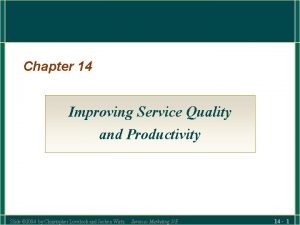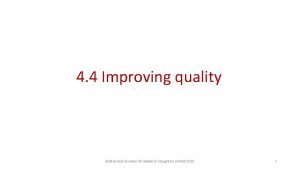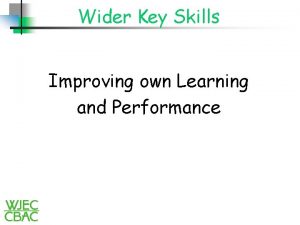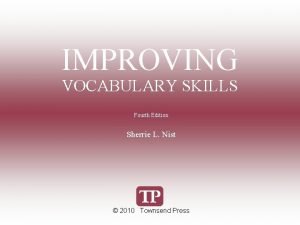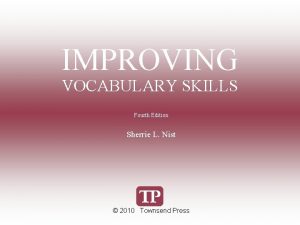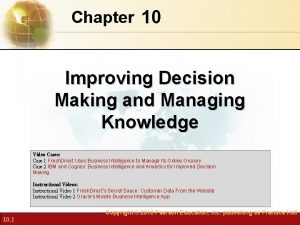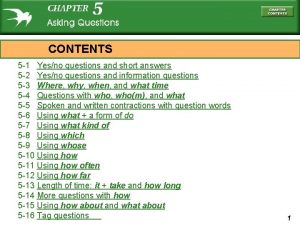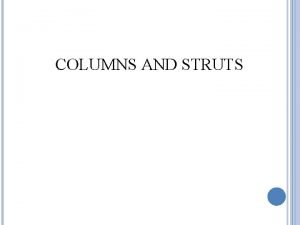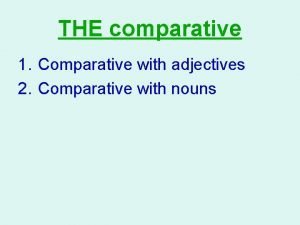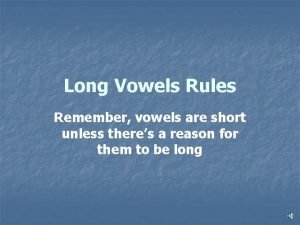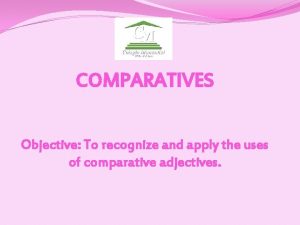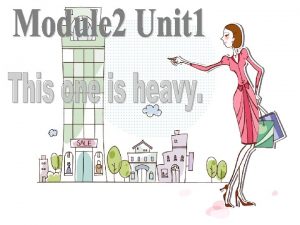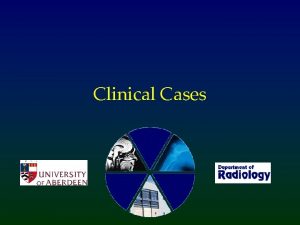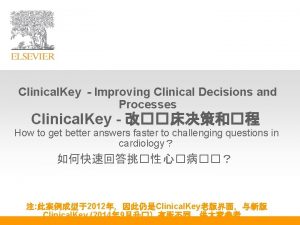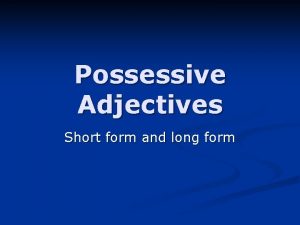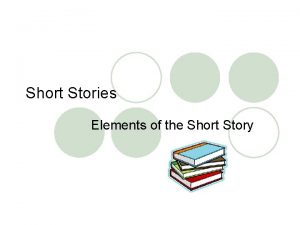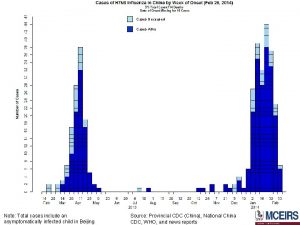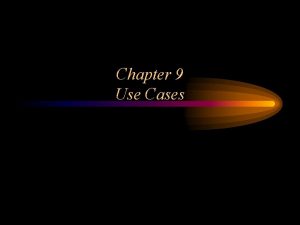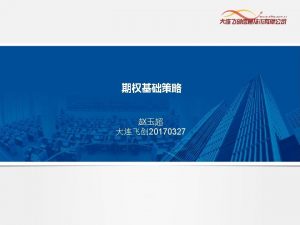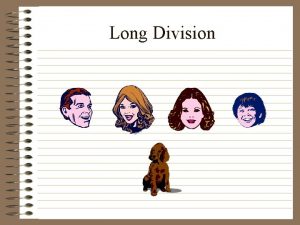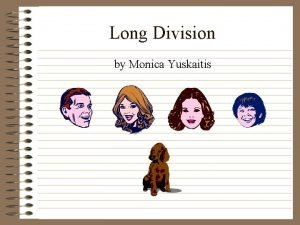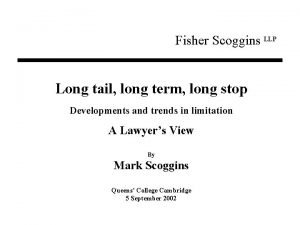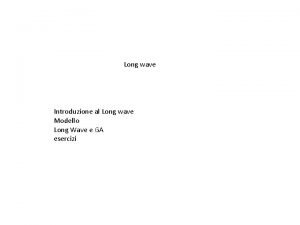Improving Long cases and short cases in clinical




























- Slides: 28

Improving Long cases and short cases in clinical examination Prof. Pushpa Raj Sharma Department of Child Health

This presentation • Teaching clinical skills • Evaluation of clinical skills

How do we teach clinical skills? • Ask students to read the skill. • Demonstrate it to the students. • Ask students to redemonstrate it. • Correct the demonstrated skill. • Ask student to rere-demonstrate it.

Common problems with clinical teaching • Lack of clear objectives and expectations • Teaching pitched at the wrong • level (usually too high) • Passive observation rather than • active participation of learners • Inadequate supervision and • provision of feedback

Common problems with clinical teaching • Little opportunity for reflection and discussion • "Teaching by humiliation" • Informed consent not sought from patients • Lack of respect for privacy and dignity of patients • Lack of congruence or continuity with the rest of the curriculum

Challenges of clinical teaching • Time pressures • Competing demands clinical (especially when needs of patients and students conflict); administrative; research • Often opportunistic makes planning more difficult • Increasing numbers of students • Fewer patients (shorter hospital stays; patients too ill or frail; more patients refusing consent) • Often under-resourced • Clinical environment not "teaching friendly" (for example, hospital ward) • Rewards and recognition for teachers poor

A child with cough or difficulty breathing • Essential skills (High morbidity, High mortality) – – – – Effective history taking Physical examination Identification of the patients problem Formulation of the differential diagnosis Planning of investigations Management Communication

Example of clinical teaching • Decide whom you are teaching? – MBBS third year students (20 students) • Decide what you want to teach? – Examination of the respiratory system. • Decide how you want to teach? – Make four group. – Ask each group to list the organs that can be examined applying inspection, palpation percussion and auscultation. – Ask each group to write the normal findings. – Ask each group to list the diseases of each organ and common clinical signs of these disease.

Example of clinical teaching (contd. ) • How I will know if students have understand? – Demonstrate examining a child for respiratory system examination. – Divide student in group of 2. – Ask them to examine a patient. – Ask them to re-demonstrate specific clinical procedure to elicit specific signs. – Discussion

What I am teaching? How will I teach it? Who I am teaching? How will I know if the Student understand

• • • Why we want to evaluate? Assessment drives learning. Observe competency for the job description. Correct the mistakes. Find out the prerequisite. Find out the adequacy of the curriculum.

What do you want to evaluate? • the existing knowledge of the disease. • the communicating skill with patient/guardian. • the writing skill. • the presentation skill. • the skill of eliciting signs. • the skill of diagnosing, investigating and treating of specific problem.

Evaluating clinical skills • Clinical history writing. – Poor reliability • Log book – Good validity but often unreliable • OSCE – Good reliability but may not be reliable for overall skills.

Long case examination, as it exist “Luck of the draw”* • Selection of the cases by examiners. • Distribution of cases randomly. • Approximately one hour for history, examination and student to synthesize. – – – Communication skill not observed at all. Process is not observed. Product is assessed. Discussion frequently on theory. Approach and expectations vary with individual examiner. *Stokes J. The clinical examination-assessment of clinical skills, medical education booklet no 2(Dundee Association for the Sudy of Medical Education)

Five required attributes of an assessment process: Reliability - a measure of the variation in scores Validity - the degree to which an assessment is a measure of what should be measured. Acceptability - the degree to which the assessment process is acceptable Feasibility - the degree to which the assessment can be delivered to all those who require Educational impact - the degree to which the assessment can assist the student to improve his or her performance,

Evaluating clinical skills • Observed clinical examination: – Good validity but poor reliability unless multiple observation made. – Time consuming, logistic problems in recruiting patients. • Non observed clinical examination – Poor reliability unless multiple cases seen. Good validity. – No assessment of student interaction with patient.

Reported Reliability when 4 h testing times are used for different test formats Wass V, Vleuten CV, Schatzer J, Jones R. Assessment of clinical competence. Lancet 2001; 357: 945 -49

Improving the long case examination • 1979: Harden and Gleeson developed the OSCE* • 1997: Gleeson developed the OSLER** *Harden RM, Gleeson FA. Assessment of clinical competence using an objective structured clinical examination (OSCE). Medical education, 1979; 13: 39 -54. ** Gleeson F. Assessment of clinical competence using the objective structured long case examination record (OSLER). Medical Teacher. 1997; 19: 7 -14

Objective Structured Long Examination Record (OSLER) • Ten item analytical record form. – 4 items for history taking, 3 items on physical examination, 1 each formulation of investigations, management and clinical acumen in a logical sequence. • All candidates are assessed on the same ten items. • Time is 20 -30 minutes for the examination. • Items are representatives: whole

OSLER’s components • History taking – Clarity of presentation, communication process, systematic approach, establishment of case facts. • Physical examination – Systematic approach, examination technique, establishment of correct physical findings. • Assessment of clinical acumen – Ability to identify and solve problems

Standardizing the long case based on the difficulty of the case • Standard case – Single problem • Difficult case – Up to three problem • Very difficult case. – More than three problem

Awarding marks in the OSLER • P+: Very good/excellent. (60 -80%0 • P: Pass/ bare pass. • P-: Below pass (50 -55%) – Each items has to be graded followed by overall grade of the complete performance

Department of Child Health Example of Paediatric Final Examinatio • • Observed by two examiner. Filling the forms with specific tasks. Grading the candidate. Both examiners grade on the specific tasks. • Average is taken.

Marks 20 Clinical Examination Skills Time allocated 5 minutes Observes professional manners, Performs proper & relevant clinical examination according to instructions given and applies correct clinical methods systematically and appropriately Proceeds appropriately according to age. Discussion Time allocated 10 minutes Gives correct findings with logical interpretation and conclusion. Justifies diagnosis/es. Suggests appropriate & relevant investigations and management (including recent advances) Exce llent Good Adequate Inadequat e Poor Comments (Comments MUST be made for all ratings of 'Inadequate' and 'Poor')

Marks 60 Time allocated 30 minutes Interviewing & Clinical Examination Skills Introduces self to patient, obtains informed consent, elicits corrected relevant history. Uses correct clinical methods systematically to elicit important clinical findings with special emphasis on detailed examination of the relevant system. Proceeds appropriately according to age. (The allocated 30 minutes – 15 minutes for each examiner) Case Presentation Examiner – 1 Name : Presentation skills Correctness of findings Logical interpretation of findings Suggests & justifies relevant investigations. E x c el le nt G o o d Adequ ate Ina deq uate Poor Comments (Comments MUST be made for all ratings of 'Inadequate' and 'Poor')

Miller’s Pyramid of Competence Miller GE. The assessment of clinical skills/competence/performance. Acad Med. 1990; 65: 563 -67

What the parents feel? Lack of informed consent 59 (51%) Inconvenient by participation 38 (55. 9%) Too many candidate per patient 25 (21. 5%) Hassle of relating the history repeatedly Inadequacy of payment 13 (1. 8%) Examining the child for too long 7 (6%) Not handling the child gently 7 (6%) 10 (8. 6%) *Arachi JK, Sumanasena SP, de Silva KSH. Clinical examination in paediatrics at final MBBS: view of children and parents. Ceylon Medical Journal; 2003, Vol 48, No 1, 12 -14.

Thank you Your suggestions regarding this presentation is highly appreciated
 Long and short
Long and short Once upon a time there was a poor girl
Once upon a time there was a poor girl Criminal cases vs civil cases
Criminal cases vs civil cases What type of bird does the tinikling dance imitates?
What type of bird does the tinikling dance imitates? Long long ago when the gods and goddesses
Long long ago when the gods and goddesses Improving service quality and productivity
Improving service quality and productivity Benefits and difficulties of improving quality
Benefits and difficulties of improving quality Improving own learning and performance examples
Improving own learning and performance examples Improving vocabulary with word parts and context clues
Improving vocabulary with word parts and context clues Improving vocabulary with word parts and context clues
Improving vocabulary with word parts and context clues Improving decision making and managing knowledge
Improving decision making and managing knowledge Long run supply curve
Long run supply curve Long division and short division
Long division and short division Short wave vs long wave radiation
Short wave vs long wave radiation Long medium and short term planning in primary schools
Long medium and short term planning in primary schools Long case and short case
Long case and short case Example of short term human resources
Example of short term human resources Long hedge in futures
Long hedge in futures Difference between long term and short term liabilities
Difference between long term and short term liabilities Long division examples
Long division examples Yes no questions and short answers
Yes no questions and short answers Euler's crippling load formula
Euler's crippling load formula Difference between long term and short term liabilities
Difference between long term and short term liabilities Long run in perfect competition
Long run in perfect competition Poetic devices meter
Poetic devices meter Adjective comparative superlative
Adjective comparative superlative Long and short vowels rules
Long and short vowels rules Long adjectives
Long adjectives Tasty syllables
Tasty syllables





